

AngularJS: More on Dependency Injection. In the AngularJS tutorials I’ve been writing, you might have noticed the use of dependency injection.
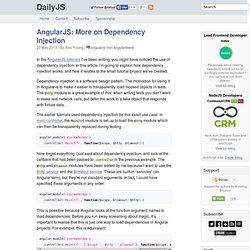
In this article I’m going to explain how dependency injection works, and how it relates to the small tutorial project we’ve created. Dependency injection is a software design pattern. The motivation for using it in Angular is to make it easier to transparently load mocked objects in tests. The $http module is a great example of this: when writing tests you don’t want to make real network calls, but defer the work to a fake object that responds with fixture data. The earlier tutorials used dependency injection for this exact use case: in main controller, the MainCtrl module is set up to load the $http module which can then be transparently replaced during testing. angular.module('djsreaderApp') .controller('MainCtrl', function($scope, $http, $timeout) { angular.module('djsreaderApp') .controller('MainCtrl', function($scope, $timeout, $http) { Yeoman and ngmin Internals Conclusion.
Nested Scopes in AngularJS — Jim Hoskins. If you haven’t yet watched, Miško Hevery’s talk on AngularJS Best Practices is well worth the watch.
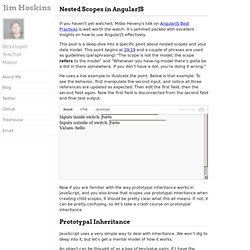
It’s jammed packed with excellent insights on how to use AngularJS effectively. This post is a deep-dive into a specific point about nested scopes and your data model. This point begins at 29:19 and a couple of phrases are used as guidelines (paraphrasing) “The scope is not the model, the scope refers to the model” and “Whenever you have ng-model there’s gotta be a dot in there somewhere. If you don’t have a dot, you’re doing it wrong.” He uses a live example to illustrate the point. Now if you are familiar with the way prototypal inheritance works in JavaScript, and you also know that scopes use prototypal inheritance when creating child scopes, it should be pretty clear what this all means.
Prototypal Inheritance JavaScript uses a very simple way to deal with inheritance. An object can be thought of as a bag of key/value pairs. Behaviour of Scope in AngularJS Directives. 0inShare Directive is the coolest and most crucial feature provided by AngularJS.

Use of the scope property in directives makes the process of writing a directive challenging. The behavior of the scope depends on the way it is assigned in the directive. AngularJS and scope.$apply — Jim Hoskins. If you’ve written a non-trivial amount of code in AngularJS, you may have come across the $scope.
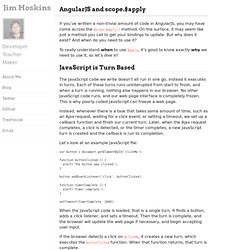
$apply() method. On the surface, it may seem like just a method you call to get your bindings to update. But why does it exist? Karma - End to End Scenario Testing for your AngularJS app. Scope. AngularJS Fun With Scopes. This is the third in a series of posts detailing my experience learning AngularJS.

This post and its accompanying example discusses the handling of scope. AngularJS scopes go hand and hand with the DOM (Document Object Model). DOM objects within a controller reference rely first on their controller counterparts for their property assignments. The example below includes three controllers: Limericks, Limerick1 and Limerick2. Limerick1 and Limerick2 use identical property names, but each are given unique values. Try changing the “Title” and “Field” values within each of the limericks. View this on JSFiddle AngularJS controllers aren’t limited to local property definitions, though.
To illustrate inheritance, {{author}} is defined only in Limericks but it’s used within all three controller objects. But wait, there’s more! Try changing the first instance by modifying the value in the “Parent pageTitle” field. Nested Scopes in AngularJS — Jim Hoskins. Nested Scopes in AngularJS — Jim Hoskins. Scoping AngularJS Directives Part 2. Scoping AngularJS Directives Part 1. AngularJS directive scoping confuses a lot of people.
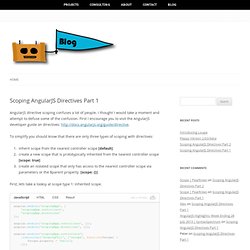
I thought I would take a moment and attempt to defuse some of the confusion. First I encourage you to visit the AngularJS developer guide on directives: To simplify you should know that there are only three types of scoping with directives: Accessing properties/methods defined under $rootScope from controllers in AngularJS. What are the nuances of scope prototypal / prototypical inheritance in AngularJS. The Battle of Modern Javascript Frameworks – Part I. Welcome to the Javascript Framework revolution.
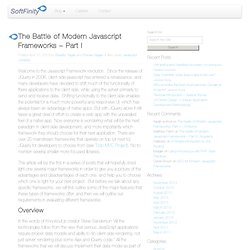
Since the release of JQuery in 2006, client-side javascript has entered a renaissance, and many developers have decided to shift much of the functionality of there applications to the client side, while using the server primarily to send and recieve data. Shifting functionality to the client side enables the potential for a much more powerful and responsive UI, which has always been an advantage of native apps. But with JQuery alone it still takes a great deal of effort to create a web app with the unparalled feel of a native app. Now everyone is wondering what will be the next paradigm in client-side development, and more importantly which framework they should choose for their next application. There are over 20 mainstream frameworks that operate on top (or next to) JQuery for developers to choose from (see Todo MVC Project). Overview Requirements Features What are the main features the framework offers?
Who are the core developers? AngularJS: Access the scope for a rendered DOM element. Empty Fiddle. AngularJS and scope.$apply — Jim Hoskins. Empty Fiddle. CSS styling. Angularjs - Why does ng-style not work on the same element as a custom directive. Angularjs - ngModel and component with isolated scope. Ng-model isolate simple 11896732. Angularjs - When writing a directive, how do I decide if a need no new scope, a new child scope, or a new isolate scope.
Scope Example. Welcome to $scope example. Scope example. Defining a Method on the Scope. Scopes - comparison 1. Problem understanding scope. AngularJS: 6 Common Pitfalls Using Scopes. Within the last month Google's "Superheroic JavaScript MVW Framework" AngularJS has gotten a lot of attention.

What makes this framework so successful compared to other JavaScript frameworks as for example EmberJS, is the value it adds to your HTML templates using (declarative) Data Binding. In the following I will describe some best practices when using AngularJS. If you are not familiar with AngularJS yet, please have a look at angularjs.org to get an overview and check out Kahlil's list of AngularJS Resources. Here are six main pitfalls when it comes to working with scopes in AngularJS. Six points which are actually easy if you understand the underlying concepts behind Angular.
A Little Excursion #1: Two-way-databinding Two-way-databinding is a big word and kind of a big deal in AngularJS. Normal binding is generally used for outputting data, actually a general concept of templating engines. Hello {{username}}! Hello John Doe! That is direction number 1. That is the second direction. AngularJS Isolated Scope Experiment. Ng-include scope. AngularJS - transclude scope.